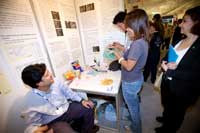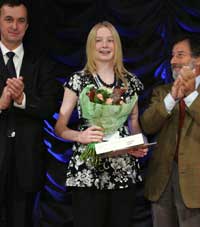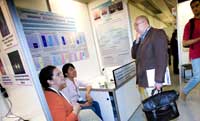Something special in the air Inspire article
Stephen Parker from the European Commission describes a contest that demonstrates the truly astonishing achievements of some aspiring young scientists.
They came from all over Europe and beyond; some had already spent hours on aeroplanes before arriving in Stockholm. They came carrying boxes and cases; some brought intricate electronic gadgetry, others just paper rolled up in tubes that they guarded as they would priceless manuscripts. Just what were these young people doing in Stockholm on that sunny Saturday in September? Clandestine participants in some secret ritual, perhaps? The astute observer, however, would not have been so misled. After all, the signs were there: it was the 18th European Union Contest for Young Scientistsw1.

Buses and coaches took the 120 contestants – all winners of national pre-university science competitions from the 33 participating countries – to their hotel; and, on Sunday, from there to the Swedish National Museum of Science and Technologyw2 where the contest was about to begin. The air was pulsating with expectation and unspoken questions: Will my project win? Can I fix this in time? Why won’t my PC boot up? Where is that adhesive tape?
Elsewhere in the museum, 15 professional scientists were finalising their preparations, but here the atmosphere was much calmer: they would be the jury, not the judged. They had already read and discussed the descriptions of the 78 projects in the contest, and were almost ready to interview the young scientists who did the work.
Soon it was the opening ceremony. Speeches from the organisers, the Swedish Federation of Young Scientists, the Swedish Research Councilw3 and the Royal Swedish Academy of Sciencew4, and music from some very talented young musicians.

receives third prize for her
project to develop and
evaluate a biological food
spoilage indicator
Then the judging began: What made you choose this project? Did you consider any other explanation for what you saw? How did you record those data? Were these measurements repeatable? Had you expected that when you started? Have you thought about protecting your work through patents? How did you split the work up between the members of your team?
Two intense hours later and the first round of interviews was over. The jury retired to exchange first impressions: When I spoke to her I realised that she really did understand the science! That project is outstanding, but who did the work? He was shy at first, but when he started to explain how he got around that technical difficulty, his enthusiasm was unstoppable! And so on.
Monday came and the judging continued. Gradually the jury began to discuss possible winners: it was difficult of course, but it always is. How can you compare a project in computational science with one in the social sciences? Professor Jane Grimson, the president of the jury, reminded her colleagues that up to three joint first, second and third prizes could be awarded. Furthermore, there were those special prizes donated by EIROforum, the European Patent Office and the Swedish Plant Science Centre. The final decisions would be taken on Tuesday after the last judging sessions.
It’s now Wednesday and the Awards Ceremony is about to begin. Everyone is seated in the Vinterträdgården of the Grand Hotel. This is where the Nobel laureates stay during the Nobel week, whispers a young contestant to her neighbour. Neither can speak each other’s first language and so they share one that they are learning at school.

There is something special in the air: an excitement that is almost tangible. More speeches, an outstanding a cappella performance by a group of young singers, and then the winners are finally announced.
Later at the press conference, Michael Kaiser from Austria, joint winner of one of the first prizes, explains: “We did not expect it! We are so satisfied and surprised that we won!” Johannes Kienl, his partner on the project, which developed an innovative electrothermal mechanical de-icing system for aircraft (see box), adds: “It was brilliant to come here and meet people from all over the world – we have made a really good network!”
For most, of course, the climax of the four-day event was the farewell party: a chance to say goodbye to new friends, or rather “au revoir”!
Some of the winning projects
Aspiring Austrian pilots Michael Kaiser and Johannes Kienl (both 19) developed a new de-icing system for aircraft. This advanced system, planned in co-operation with two offices of technical engineers, can be used to de-ice all important aerofoils of aircraft and wind-power stations. Attached to an aircraft’s wings or vertical and horizontal stabilizers, or to the rotors of wind-power stations, the device pushes ice off the surface when a heated metal layer expands. This has a significant advantage over conventional de-icing systems: Michael’s and Johannes’s invention only requires heat and power when ice is actually present, in contrast to the traditional ‘bleed air system’, which has to use power to heat the aerofoils whenever the aircraft is at risk of icing. The advanced Austrian de-icing system also has the advantage in terms of weight, size, energy efficiency and power.
Table tennis probably is one of the fastest sports in the world for both players and spectators. Johannes Burkart (20) and Alexander Joos (19), both of whom aim to be physicists, were fascinated by how professional table-tennis players manage to place balls exactly on the edge of the table and serve difficult top-spins, so they wanted to understand and simulate the curve of the flying ball. Using a computer, the young scientists analysed the paths of balls served by a training machine, then compared flight curve experiments with simulated trajectories and were able to imitate several real table-tennis situations.
Heart diseases are among the most common causes of death in humans. One group of drugs often used to treat these diseases is beta-blockers, such as propranolol and metoprolol. Tomek Wdowik (19) from Poland carried out a complex organic chemical synthesis to produce a new compound that may add a new and efficient drug to the family of beta-blockers. Tomek, who would like to become a chemist, explained the action of the known beta-blockers and described how he designed and performed his synthesis
Web References
- w1 – Official Website of the European Union Contest for Young Scientists The 18th European Union Contest for Young Scientists took place in Stockholm, from 23-27 September 2006. A complete list of the winning projects can be found on the official website. In 2007, the contest will take place in Valencia.
- The European Union Contest for Young Scientists is an initiative of the European Commission to promote co-operation and interchange between young scientists, and demonstrate the best in European student scientific achievement. By giving young scientists the chance to meet others with similar abilities and interests and to be guided by some of the most prominent scientists in Europe, the European Commission seeks to strengthen the efforts made in each participating country to attract young people to careers in science and technology.
- w2 – Tekniska Museet
- w3 – The Swedish Research Council
- w4 – The Royal Swedish Academy of Science
Institutions






